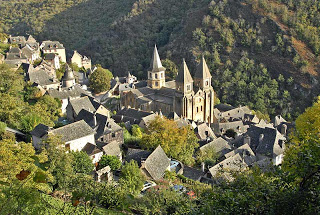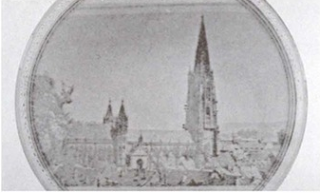Medieval History
I'm thinking through the responses of two students in my Ren-Mod survey who, when asked to comment on images (such as the one on the left) made by bacteria, made a scaled comparison between bacteria and humans. Shifts in scale are as fantastic as allegories or really, really good metaphors in my book. They ask for impossible things (things you can't really have in your experience of the world), but impossible things that make possible things make sense. Shifts in temporal scale (Jeffrey Cohen asking us to think about the rapidity and variety of geological change within the temporal framework of rocks themselves); shifts in physical scale (yes, I'm still gripped by Eileen Joy's sighting of our chemical signature in the galaxy as our greatest work of art); and these student responses I think I would dub shifts in performative scale. This image (and others like it if you follow the link in the caption) is made by shading the area you wish to remain light (because this bacteria is nourished by light and will move towards it, leaving the shadowed/dark areas unmarked by their darkening presence). The test question asked them to draw on the periods we'd studied to come up with a new name for this art that coaxed bacteria into making images. A lot of students went with some riff on Conceptual Art; others invented different kinds of Primitivisms (bacteria being one of the most primitive forms of life - at least within the framework of the human scale); one dubbed it "Bio-Constructivism," another, "performance art" (because the bacteria is alive!). But these two students took a different direction, claiming that humans, too, flocked to resources and established themselves there, leaving empty the negative space - just like the bacteria here. One student even claimed cathedrals as bacterial growth on the landscape, humans having long flocked to resources to make images there.
I immediately thought of Glaber's turn of the millenium quote about the "great mantle of white churches" - here's the full quote, pulled from a passage in which Glaber is discussing the restoration of churches around the year 1000.
This shot of beautiful Conques reveals the idea of concentration that my students put forward. It's the combination of both citing cathedrals as bacteria, and of noting that humans are drawn to resources - that that's where they leave their mark, their artistic gesture. The white mantle of churches is, now that I think about it, an intermediary of performative scale: in its cloaking (meant to be comforting?) gesture, it is somewhere between the rapacious colonizing of bacteria and humans. Does all of this make the white mantle more sinister, less sweeping a gesture? Of course, but it keeps the aestheticization of the gesture. You get an image when you think about it.
And so it all comes together here, in an image of a cathedral made by bacteria. You can get pretty subtle in your manipulation of bacteria, eh? So yes, the bacteria is guided, moved, willed by humans (and we can have some nice debates about who the artist/the maker of images are here, and if intentionality and agency are required for artistic production, and if so, to what degree and whence) - but to a one, the students saw the phrase "Hello World" as spoken by the art bacteria. Some were a little freaked out by it: and I savored thinking about how much writing is presence.
It's late, and there's still much grading to be done, but I can't help but wonder about the artistic gestures of bacteria on medieval art: on wood, on sculpture, on paint, on ivory, on manuscript) - or of other tiny micro-organisms. Those traces left behind by the presence of these micro-organisms as they wear on the work of art; or the dependence medieval artists had on these micro-organisms to make/preserve their art (enzymes in human saliva to clean alabaster, for example). The smallest scale of medieval artistic production that I can think of are the bees who make (ah, what else?) a cathedral inside their hive, after someone has secreted a consecrated host there (where is that miracle from? is that from Caesarius of Heisterbach? ooo, I'd love to know/remember). We flock to our resources, and we make art there - we gather and collaborate and leave shadows; from chemical signatures in the galaxy to cathedrals in a Petri dish.
- Researchers Discover Original Bacteria Of The Black Death
The bacteria responsible for causing the 1348 Black Death, identified as one of the most cataclysmic events in human history, has been identified by researchers from Canada and Germany. Using a novel method of DNA enrichment coupled with high-throughput...
- Discover/uncover
Saint-Cybard at Plassac-Rouffiac, 12th-century (Charente)I'm getting ready to re-read a book written by my advisor, Linda Seidel that I've taught but haven't read since graduate school. I'll be reading Songs of Glory to think about...
- Natural Beauty/acheiropoieta
Agate from Roger Caillois, The Writing of StonesNatural beauty is harder to define than you'd think. And I should read Kant and find out if he provides some transcendental loophole, and I should pull out Umberto Eco and see what he has to say. But...
- Tiydk #3: Squire Boone Caverns
UpWe lost the heat very quickly (it couldn't possibly follow us all 160 feet down), and then, soon after, we lost a predictable sense of scale, a proper sense of time - gone in the wonder and the questioning and the incredible busyness of caverns....
- Everything And More
Annunciation, 1400s.The meeting with Jim the geologist and Dan the chemist was terrific. This vivid (look at the breath of God!) alabaster Annunciation from the Philadelphia Museum of Art will help here. What is this profound thrill of newly gained knowledge?...
Medieval History
Issues of Scale
 |
| Very Cool Project |
 |
| Conques |
"[I]t was as though the very world had shaken herself and cast off her old age, and were clothing herself everywhere in a white garment of churches."
This shot of beautiful Conques reveals the idea of concentration that my students put forward. It's the combination of both citing cathedrals as bacteria, and of noting that humans are drawn to resources - that that's where they leave their mark, their artistic gesture. The white mantle of churches is, now that I think about it, an intermediary of performative scale: in its cloaking (meant to be comforting?) gesture, it is somewhere between the rapacious colonizing of bacteria and humans. Does all of this make the white mantle more sinister, less sweeping a gesture? Of course, but it keeps the aestheticization of the gesture. You get an image when you think about it.
 |
| Same Cool Project |
It's late, and there's still much grading to be done, but I can't help but wonder about the artistic gestures of bacteria on medieval art: on wood, on sculpture, on paint, on ivory, on manuscript) - or of other tiny micro-organisms. Those traces left behind by the presence of these micro-organisms as they wear on the work of art; or the dependence medieval artists had on these micro-organisms to make/preserve their art (enzymes in human saliva to clean alabaster, for example). The smallest scale of medieval artistic production that I can think of are the bees who make (ah, what else?) a cathedral inside their hive, after someone has secreted a consecrated host there (where is that miracle from? is that from Caesarius of Heisterbach? ooo, I'd love to know/remember). We flock to our resources, and we make art there - we gather and collaborate and leave shadows; from chemical signatures in the galaxy to cathedrals in a Petri dish.
- Researchers Discover Original Bacteria Of The Black Death
The bacteria responsible for causing the 1348 Black Death, identified as one of the most cataclysmic events in human history, has been identified by researchers from Canada and Germany. Using a novel method of DNA enrichment coupled with high-throughput...
- Discover/uncover
Saint-Cybard at Plassac-Rouffiac, 12th-century (Charente)I'm getting ready to re-read a book written by my advisor, Linda Seidel that I've taught but haven't read since graduate school. I'll be reading Songs of Glory to think about...
- Natural Beauty/acheiropoieta
Agate from Roger Caillois, The Writing of StonesNatural beauty is harder to define than you'd think. And I should read Kant and find out if he provides some transcendental loophole, and I should pull out Umberto Eco and see what he has to say. But...
- Tiydk #3: Squire Boone Caverns
UpWe lost the heat very quickly (it couldn't possibly follow us all 160 feet down), and then, soon after, we lost a predictable sense of scale, a proper sense of time - gone in the wonder and the questioning and the incredible busyness of caverns....
- Everything And More
Annunciation, 1400s.The meeting with Jim the geologist and Dan the chemist was terrific. This vivid (look at the breath of God!) alabaster Annunciation from the Philadelphia Museum of Art will help here. What is this profound thrill of newly gained knowledge?...
